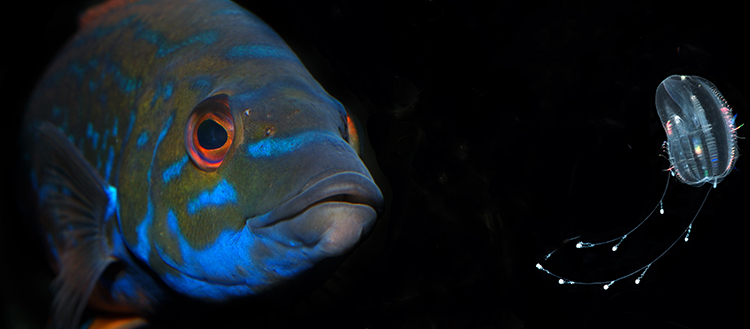Biodiversity hypothesis called into question
The trade-off between gleaners and exploiters does not explain the diversity of biological species in the way that scientists expected. Our understanding of biodiversity has to change.

Aquatic organisms - and terrestrial ones - that do best when there is lots of food also do best when there is very little. ©DTU/ Erik Selander
Biologists have long considered the origins and continued coexistence of the immense diversity of species found in our environment. How can we explain the fact that no single species predominates? A generally accepted hypothesis is that there are trade-offs, which means that no organism can do best in all conditions. One trade-off that is commonly assumed is that between gleaner organisms —which are able to acquire and consume more food than other species when resources are scarce— and exploiters, which rapidly consume large quantities of the same resources when they are in abundance. However, when scientists from the the University of Geneva (UNIGE) and the Technical University of Denmark (DTU) analysed the consumption of food resources of over 500 terrestrial and aquatic species, they showed that organisms that are efficient when there are low quantities of food, are also best when food resources are abundant. Consequently, biodiversity cannot be explained as a trade-off between gleaners and exploiters. Instead, the idea of risk taking to obtain food needs to be considered, as explained in this PNAS publication.
Dealing with trade-offs is one of the challenges organisms faces when they have to gain the energy needed to grow, defend themselves and reproduce. “If there were no trade-offs, the species that is the most effective in all conditions would come out on top,” begins Mridul Thomas, senior research and teaching assistant in the Department F.-A. Forel for Environmental and Aquatic Sciences in UNIGE’s Faculty of Sciences and the study’s second author. “These trade-offs—and variations in environmental conditions—help explain why species are different and why we have diversity. No species can be best in all conditions.”
Indeed, there is wide agreement in the scientific community that biodiversity can be explained partly through the gleaner-exploiter trade-off, which arises from the need to invest in both acquiring food and in quickly extracting energy and nutrients from it. Scientists expect organisms living in low-food environments to be gleaners that can quickly search for resources over large areas. Conversely, organisms living in food-rich environments are exploiters that consume resources in abundance and at great speed. Both these strategies can result in success depending on the environmental conditions encountered. And if the food availability changes through time or across space, it can allow competing gleaners and exploiters to co-exist, leading to diversity.
No gleaner-exploiter trade-off in nature
“Although it’s taught commonly and is found in text books, there’s little experimental evidence for the gleaner-exploiter trade-off,” says Mridul. This is exactly the subject that Thomas Kiørboe, professor at the National Institute of Aquatic Resources at DTU—and first author of the study—decided to investigate. In an attempt to provide an answer, Professor Kiørboe has been collecting data found in the scientific literature on the food consumption of hundreds of species, derived from estimates from organisms ranging from single cells to large mammals living both in terrestrial and aquatic environments.
This immense collection of data has made it possible to analyse the speed at which over 500 species acquire and consume food. “For each species, such as a spider, scientists measured how fast it was able to capture and eat food, and they did this when food was abundant and when it was rare. Thanks to this valuable work by many scientists for hundreds of species, we were able to compare this across many organisms,” continues Mridul. Curves of the speed of consumption as a function of the abundance of food are derived from this data, making it possible to describe the performance of the organisms in both low and high food conditions. “A negative correlation is expected from the gleaner-exploiter trade-off, but our results show a positive relationship”, a clear indication, according to the biologist, that the gleaner-exploiter trade-off does not exist. Kiørboe and Mridul have demonstrated that species that perform well in an environment where energy resources are scarce are also the best in a rich environment.
Unexplained biodiversity
However, the researchers’ interpretation does not call the concept of trade-offs into question. “Without trade-offs, it is very hard to maintain diversity. Our research does not explain biodiversity, but it does overturn an existing theory about precisely why we have biodiversity,” says Mridul. Accordingly, there should be another trade-off: “A trade-off about risk-taking to access food is more likely, and would be consistent with our results. For instance, an organism may be better at getting food whether food is scarce or abundant because it takes more risks. Getting more food is generally good because it helps organisms grow and reproduce. But if in searching for food the organism gets eaten itself, it cannot reproduce. So it can sometimes be good to avoid taking these risks even if it means getting less food —which would explain why we see in our study that some species seem very good at getting food and some very bad at it.” Whatever this other trade-off is, the Danish-Swiss study fundamentally changes an important idea about why we have biodiversity that is still being taught and has been taken for granted. It follows that our understanding of ecosystems must be revisited, since this knowledge is essential in the face of the environmental upheavals we are witnessing today.
21 Sept 2020
